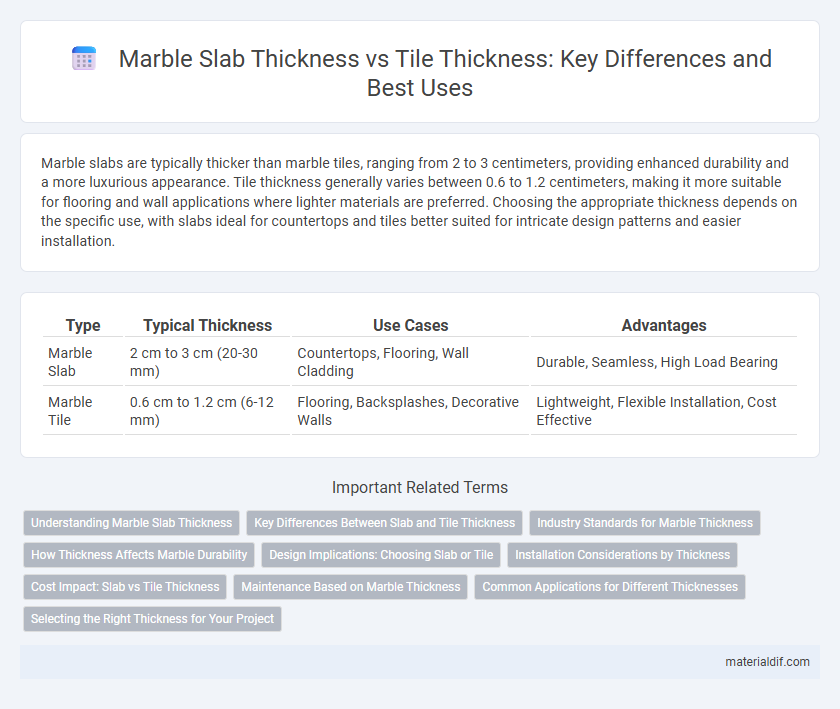Marble slabs are typically thicker than marble tiles, ranging from 2 to 3 centimeters, providing enhanced durability and a more luxurious appearance. Tile thickness generally varies between 0.6 to 1.2 centimeters, making it more suitable for flooring and wall applications where lighter materials are preferred. Choosing the appropriate thickness depends on the specific use, with slabs ideal for countertops and tiles better suited for intricate design patterns and easier installation.
Table of Comparison
| Type | Typical Thickness | Use Cases | Advantages |
|---|---|---|---|
| Marble Slab | 2 cm to 3 cm (20-30 mm) | Countertops, Flooring, Wall Cladding | Durable, Seamless, High Load Bearing |
| Marble Tile | 0.6 cm to 1.2 cm (6-12 mm) | Flooring, Backsplashes, Decorative Walls | Lightweight, Flexible Installation, Cost Effective |
Understanding Marble Slab Thickness
Marble slab thickness commonly ranges from 2 cm to 3 cm, providing greater durability and structural integrity compared to tile thickness, which typically measures 1 cm to 1.5 cm. The increased thickness of marble slabs makes them ideal for high-traffic areas and heavy-use surfaces such as countertops and flooring, as they resist cracking and chipping more effectively. Understanding the differences in thickness helps in selecting the appropriate marble material for specific applications, balancing aesthetics with functional performance.
Key Differences Between Slab and Tile Thickness
Marble slabs generally range from 2 to 3 centimeters in thickness, providing enhanced durability and structural integrity for countertops and large surface installations. Marble tiles typically measure around 0.6 to 1 centimeter thick, designed for flooring and wall applications where flexibility and ease of handling are crucial. The increased thickness of slabs supports heavy-duty use, while thinner tiles offer versatile design options with lighter weight and simpler installation.
Industry Standards for Marble Thickness
Industry standards for marble thickness typically specify slabs at 2 cm or 3 cm to ensure durability and stability in countertops and architectural applications. Tile thickness generally ranges from 0.6 cm to 1.2 cm, optimized for flooring and wall cladding where lighter weight and ease of installation are critical. Adhering to these standardized thicknesses guarantees structural integrity and aligns with fabrication and installation requirements within the marble industry.
How Thickness Affects Marble Durability
Marble slab thickness directly impacts its durability, with thicker slabs typically offering enhanced strength and resistance to cracking under weight or pressure. Standard marble slabs usually range from 2 cm to 3 cm, whereas tiles are often thinner, around 1 cm, making slabs more suitable for high-traffic or heavy-use applications. Thicker marble slabs also provide better heat resistance and reduced susceptibility to chipping compared to thinner tiles, extending the lifespan of marble installations.
Design Implications: Choosing Slab or Tile
Slab thickness typically ranges from 2 to 3 centimeters, offering durability and a sleek, seamless appearance ideal for countertops and large surfaces, while tile thickness varies from 0.6 to 1 centimeter, allowing greater flexibility for intricate patterns and wall designs. Thicker slabs provide enhanced structural support and a premium aesthetic, making them suitable for heavy-use areas, whereas thinner tiles suit flooring and feature walls with complex layouts. Design implications hinge on project requirements: slabs deliver minimal grout lines and a uniform surface, enhancing modern luxury, while tiles enable customizable textures and patterns, supporting versatile interior styles.
Installation Considerations by Thickness
Marble slab thickness typically ranges from 2 to 3 cm, providing enhanced durability and fewer seams, which simplifies installation in larger surfaces like countertops and flooring. Tile thickness is generally around 1 to 1.2 cm, requiring more grout lines and subfloor preparation to ensure proper adhesion and prevent cracking. Thicker slabs demand sturdier support structures and specialized cutting tools, while thinner tiles offer more flexibility but necessitate precise leveling for optimal installation performance.
Cost Impact: Slab vs Tile Thickness
Marble slab thickness typically ranges from 2 to 3 centimeters, while tile thickness is generally around 1 centimeter, which significantly influences material costs. Thicker slabs demand more raw marble and require specialized handling, raising the overall expense compared to thinner tiles. This thickness disparity directly impacts installation costs, with slabs often necessitating more labor and structural support, thereby increasing the total project budget.
Maintenance Based on Marble Thickness
Marble slab thickness typically ranges from 2 to 3 centimeters, offering greater durability and resistance to wear compared to thinner tiles, which are usually around 1 to 1.2 centimeters thick. Thicker marble slabs require less frequent maintenance and polishing due to their enhanced structural integrity, making them ideal for high-traffic areas. In contrast, thinner marble tiles demand more careful upkeep to prevent chipping and staining, as they are more susceptible to damage over time.
Common Applications for Different Thicknesses
Marble slabs typically range from 2 to 3 centimeters in thickness, making them ideal for countertops, kitchen islands, and large surface areas requiring durability and structural support. Marble tiles, generally 0.6 to 1 centimeter thick, are commonly used for flooring, wall cladding, and backsplashes where lighter weight and easier installation are advantageous. Thicker slabs offer enhanced resistance to cracking under heavy use, while thinner tiles provide design versatility for intricate patterns and vertical applications.
Selecting the Right Thickness for Your Project
Choosing the appropriate marble slab thickness is crucial for ensuring durability and aesthetic appeal in construction projects, with common slab thicknesses ranging from 2 cm to 3 cm. Tile thickness, typically between 1 cm and 2 cm, suits flooring and wall applications where lightweight and easy installation are priorities. Selecting the right thickness depends on the project type, load requirements, and installation environment, balancing strength needs with design preferences.
Slab thickness vs Tile thickness Infographic

 materialdif.com
materialdif.com